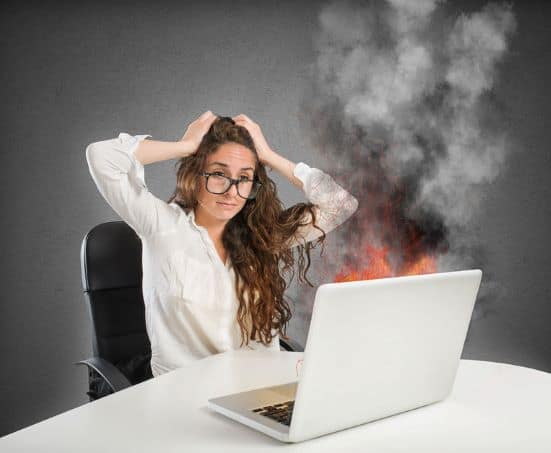
When it comes to portable computing devices like laptops, so many different electronic components are crammed in so little space that overheating is pretty common to experience.
You might be wondering, why does my laptop keyboard get hot and how to cool it down? Well, if that’s the case, you’re exactly in the right place. This is what I’m here to tell you.
Your laptop keyboard gets hot because of the internal components inside the laptop such as the graphics card and processor. However, if the temperature is over 40 degrees celsius at idle, or 70 degrees celsius while being used, then it might be overheating.
There are a few ways you can cool down a laptop keyboard. First, never overstress your laptop, if you did let it rest for an hour or so. Also, cleaning the fans and other components, using keyboard feet to elevate the laptop to allow airflow, and using overheat protection software are all ways to prevent your laptop keyboard from getting too hot.
In this article, we’re going to talk about what your laptop keyboard getting hot means and how hot is normal for a laptop keyboard. We’re also going to talk about how to fix the overheating and how to cool the laptop keyboard down. So, sit back, relax, and read this article till the end.

Table of Contents
Why is the Laptop Keyboard so Hot?
Many people around the world experience their laptop keyboards getting hotter than usual because beneath the keyboards are all the components like the RAM, processor and if there is a dedicated graphics processing unit, that as well.
The main reason for your laptop keyboard getting so hot is most likely because of overheating. But that isn’t always the case. Components do sometimes reach temperatures that seem a little hot to us but are perfectly fine for the health of the laptop.
At the same time, you definitely need to keep an eye on your laptop temperature in order to ensure a long usage life for it. And you should never rule out the risk of the laptop being excessively overheated and causing problems and damage to the internal components.
How Hot Can a Normal Laptop Get?
This is what you need to understand. You need to learn about what is the optimal temperature for a laptop that is either idle or working under load. Let’s take a look at the optimal temperatures of a laptop and its keyboard which are both working perfectly fine.
Optimal Idle Temperatures
When your laptop is idling, which basically means that it is not performing any actions and is simply not loading programs or doing any tasks, the optimal temperatures should be around 30-40 degrees Celsius.
This is the normal temperature for a laptop with or without a GPU because, in idle time, the GPU is mostly turned off automatically and behaves similar to a laptop without a GPU in it.
Optimal Under-load Temperatures
When you’re playing a demanding game on the laptop and you’re pressing the keys on the laptop keyboard, or you’re working on a large software or surfing the internet, the machine is under-load.
In such cases, the temperatures that your laptop should be at will vary from around 50-70 degrees Celsius on average and that is exactly how much the optimal temperature for your laptop will be. If your laptop is at these temperatures, you don’t have much to worry about and it may just be that your hands were cold when you touched the laptop keyboard.
When Does a Laptop Overheat?
We know what temperatures are optimal for laptops now, but the question still remains, when does a laptop overheat? Well, basically from the optimal temperature reading, we can take a deduction of excessive temperatures as well. Let’s take a look at that.
Excessive Idle Temperature
If you’re sitting in front of your laptop and you try pressing a key on the keyboard and it feels incredibly hot, the idle temperature might be around 50 degrees Celsius. And believe me, from experience I’m telling you that it is the high temperature for idle time.
Although it might not be harmful to your laptop right now, if you put an excessive load on it, the temperatures might actually rise up enough to damage the internal components of the laptop.
Excessive Under-load Temperature
If your laptop has a temperature issue, gaming and intense workload are going to prove incredibly difficult on it. While multitasking, the temperatures you might face can go even greater than 90 degrees Celsius and that can cause severe problems in your laptop.
Not only will it cause throttling but also part damage and shortage of the lifespan of the components inside the laptop. You shouldn’t let your laptop reach these temperatures and try to keep things under control by getting your laptop repaired.
4 Signs to Look for to Know if the Laptop is Overheating
There are actually a number of ways you can get to know if your laptop is overheating. I’ve shortlisted a bunch of ways that you can know if your laptop is undergoing excessive temperature shoots without using a thermometer to measure the temperature. Let’s take a look at each of them.
| Laptop Condition | Safe Temperature | Needs repair |
|---|---|---|
| Idle or single programs | 30-40 degrees celsius | 50+ degrees celsius |
| Using programs and multitasking | 50-70 degrees celsius | 90+ degrees celsius |
1. The Laptop Keyboard is Incredibly Hot
The most basic way of knowing if your laptop is overheating is by touching the keys. If you are trying to type using the laptop keyboard and you feel like the keys are getting too hot to touch, it would definitely mean that the airflow of the laptop isn’t doing a great job.
This means that the processor and the RAM are at risk of actually getting damaged due to high temperatures and even the keyboard may become unusable after a while. So, you can touch and know if the laptop is overheating under normal circumstances.
2. Automatic Shut down
In some laptops, particularly, Macbooks, there is a feature that allows the laptop to basically go to sleep or shut down when the device is actually overheating.
This automatic shutdown lets the user know that there is a thermal issue with the laptop that they’re using. This feature is slowly being introduced in other devices as well.
3. Software Detection
If there’s no automatic thermal detection in your laptop, you can always use different software for Windows and other operating systems. Softwares like MSI afterburner or Core Temp CPU are very useful in this case.
They’ll be able to detect the temperatures of your laptop at all times and then you can make the right decision depending upon which would be the accurate solution for your overheating problem.
4. Thermal Throttling
Thermal throttling is the process of a computer device slowing down the processing speed and core clocks in order to reduce the excessive temperatures achieved by the CPU and other components due to the high workload.
If a laptop is overheating, naturally it will experience slowness in the speed due to thermal throttling and if your laptop does that, it means that it is definitely overheating due to some problems.
How to Cool the Laptop Down?
There are a lot of different non-technical ways you can get your laptop cooled down. However, if none of them work, the best course of action would be to simply get the laptop repaired. Let’s take a look at the best ways of cooling down your laptop and reducing overheating issues.
Fix 1: Cleaning the Fan
Sometimes, dust and debris can actually affect the working of the exhaust fan inside your laptop. If you’re alright with opening the back of your laptop and unscrewing some of the screws to reveal the fan, then you should definitely try this fix. You can use tissue paper or a blower fan to get rid of the dirt and dust off the fan.
You’ll see the incredible amount of change the thermals are going to experience with this single trick. This might be the only thing you need to fix your laptop’s thermal issues.
Fix 2: Using Overheating Protection Software
There are software tools available that allow you to not only monitor the temperatures of your laptop but also to control the fan speeds as well as the temperature limit of the machine.
You can set the temperature limit to a certain point and if the machine exceeds that point, it will throttle or simply shut down reducing the risk of overheating related issues that cause damage to the components of the laptop.
Fix 3: Do not overstress the Laptop
If your laptop isn’t built for excessive workloads and gaming at the same time, you should definitely try giving it a bit of rest and reduce the multi-tasking on it. You should rather go for a single demanding application at a time and not overstress your laptop in order to control the thermals.
Fix 4: Use a flat surface with elevated sides
In order to provide better airflow to your laptop, you should place it on a laptop stand that comes with elevated sides that allow the laptop to have better airflow than before making the thermal temperatures lower than usual. This helps significantly to reduce thermal issues and problems of overheating to make your laptop perform better.
Conclusion
Laptops are meant to heat up, but at some point, the temperature becomes too hot to handle. That’s when you’re going to need to follow the steps that I’ve provided to you in this article.
By following these overheating solutions, you’re going to put an end to the excessive temperature problems your laptop might be facing. I hope your laptop and keyboard remain at optimal temperatures idling and under-workload.
